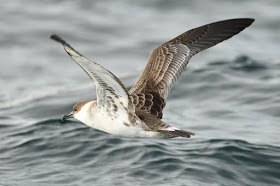The Marazion bird is the first Baird's Sandpiper of the season and represents the 36th record for the county. It remained on the beach around the Red River outlet for just over a week.
Regarding past Baird's records in Cornwall, the exact numbers are curiously difficult to reconcile as records rejected by the BBRC are in fact included in the official CBWPS file. Including this bird, there has been a total of approximately 36 birds, the first of which apparently occurred in 1965, though this bird does not appear in the CBWPS Report as it was rejected (presumably by BBRC). A similar fate happened to another report in 1966. Thus the first authentic Cornish record was at Ruan Lanihorne and is attributed to Ted Griffiths and Stan Gay in 1980.
1980 Ruan Lanihorne 31 Aug - 2 Sep
1980 Predannack Airfield 20 Sep
1980 Davidstow 21 Sep - 1 Oct
1981 Davidstow 22 - 24 Sep (not in 1981 report)
1981 Marazion 28 Sep - 10 Oct
1981 Ruan Lanihorne 15 Oct - not in BBRC
1983 Siblyback first year 3 - 18 Sep
1983 Camel ad. 14 Sep
1983 Davidstow 15 - 16 Sep
1983 Marazion Beach 20 - 25 Sep
1983 Carnsew Pool 28 Sep (rejected)
1984 Record at Crowdy Res/Davidstow 12 Sep (rejected)
1984 Siblyback 26 - 29 Sep
1988 Stithians first year 4 - 15 Sep
1989 Stithians first year 24 - 30 Oct (per 1990 report)
1989 Crowdy first year 1 – 11 Oct
1995 Upper Tamar Lake first year 15 - 18 Sep
1995 Colliford Lake first year 23 Sep then Dozmary Pool on 24 Sep
1997 Gannel Est on 3 Aug.
1997 Hayle Est. on 31 Aug.
1997 Devoran, Restronguet Creek on 10 - 21 Sep
1998 Davidstow (2) one 11 - 20 Sep, with a second on 16 Sep
1999 Camel ad 22 - 25 Aug
2001 Long Rock Beach, Marazion 16 Sep – 17 Oct
2004 Crowdy/Davidstow 4 – 21 Sep, but (2) on 7 + 10 Sep
2004 Marazion Beach 7 – 11 Sep and 15 – 16 Sep
2004 Stithians 13 – 26 Sep
2005 Hayle Est 1 Sep (not in BBRC)
2006 Hayle 8 – 13 Sep (possibly another bird 4 Oct not submitted to BBRC)
2006 St John’s Ford 20 Sep
2006 Trevose Head 23 Sep (not submitted to BBRC)
2009 Marazion Beach 3 Sep to at least 17th Sep
2009 Davidstow 1 Sep to at least 16th Sep
2011 Hayle Estuary 30th Aug to 11th Sep
2012 Marazion beach an adult photographed, 31st Aug.
2016 Gannel Estuary 25th-27th Sept
2016 Davidstow 2nd Oct-12th Oct, presumed same individual from the Gannel.
2017 Marazion beach juv 3rd-11th Sept
Historic Totals Aug 7, Sep 26, Oct 3. The most popular site is Marazion Beach with nine records here.


















































